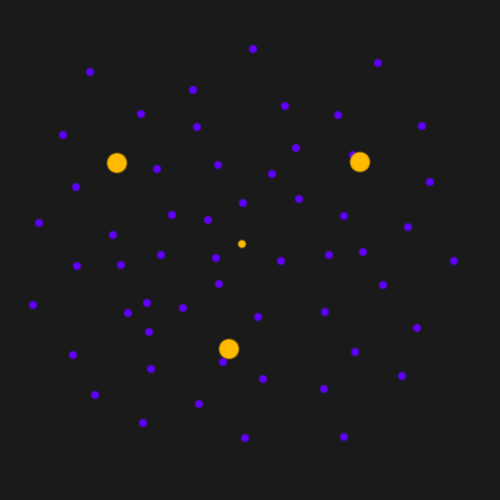This post is also available in Dutch.
During the time I spent studying psychology I saw many visual illusions, but motion induced blindness is still the most impressive. On the picture below there are four orange dots. Look at any of those dots for a minute or so, and you will see that the other three dots start to blink on and off, and then completely disappear.
 Image by Alina
Image by Alina
The illusion basically consists of two parts: several stationary figures, which are called targets, and a group of moving figures, which is called the mask. So how could our brain possibly fail to see a bright orange dot on a black background when it is right in front of our eyes? We do not know yet, but researchers have experimented with many parameters to see under what condition this illusion occurs. For example, it turns out that the targets and mask can be any shape and color, and arranged in any configuration. Smaller targets disappear more easily than big targets, and paradoxically, brighter targets also disappear more easily. If the targets are grouped to form a larger figure, they tend to disappear as a whole rather than in separate parts. As for the mask, if it rotates in a circle then the illusion works best, but linear movement in one direction or random motion can still work.
What happens in the brain
Donders researchers Barbara Handel and Ole Jensen also studied motion-induced blindness. Participants sat in front of the screen and pressed a button each time they saw a target disappear. The experiment was created such that half of the time targets actually disappeared from the screen, while the other half of the time there was the illusion of disappearance (i.e. the targets stayed on). The researchers found that just before the illusionary disappearance brain regions involved in processing visual information did not seem sufficiently focused on both the targets and the moving mask. This is probably why the brain focused on the mask and temporarily ignored the targets.
In turn, after both illusory disappearances and real disappearances the brain activity in areas involved in attention showed an increase. Probably, other parts of the brain noticed a change (a dot that just disappeared) and sent the signal to the cortical visual system to concentrate more. In the case of an illusory disappearance this increase in attention was not enough to bring back the disappeared target. So a temporary lack of attention focus is not enough to explain the illusion, and there are some other mechanisms involved that we don’t yet know about.
Why is it important?
How often do we have to look at orange dots on a black background? This type of visual information does not seem to resemble a real life scene. Yet, motion induced blindness does work on more realistic objects: Imagine driving on a straight road with trees moving past you on both sides, or piloting an airplane. Failing to see an object in front of you because of motion-induced blindness could cost lives!
 Image by Alina
Image by Alina
More information
Article on motion induced blindness
Article on motion induced blindness and brain oscillations
Here you can experiment with different parameters to see what works best for you
This blog was written by Alina and can also be read in Dutch.
